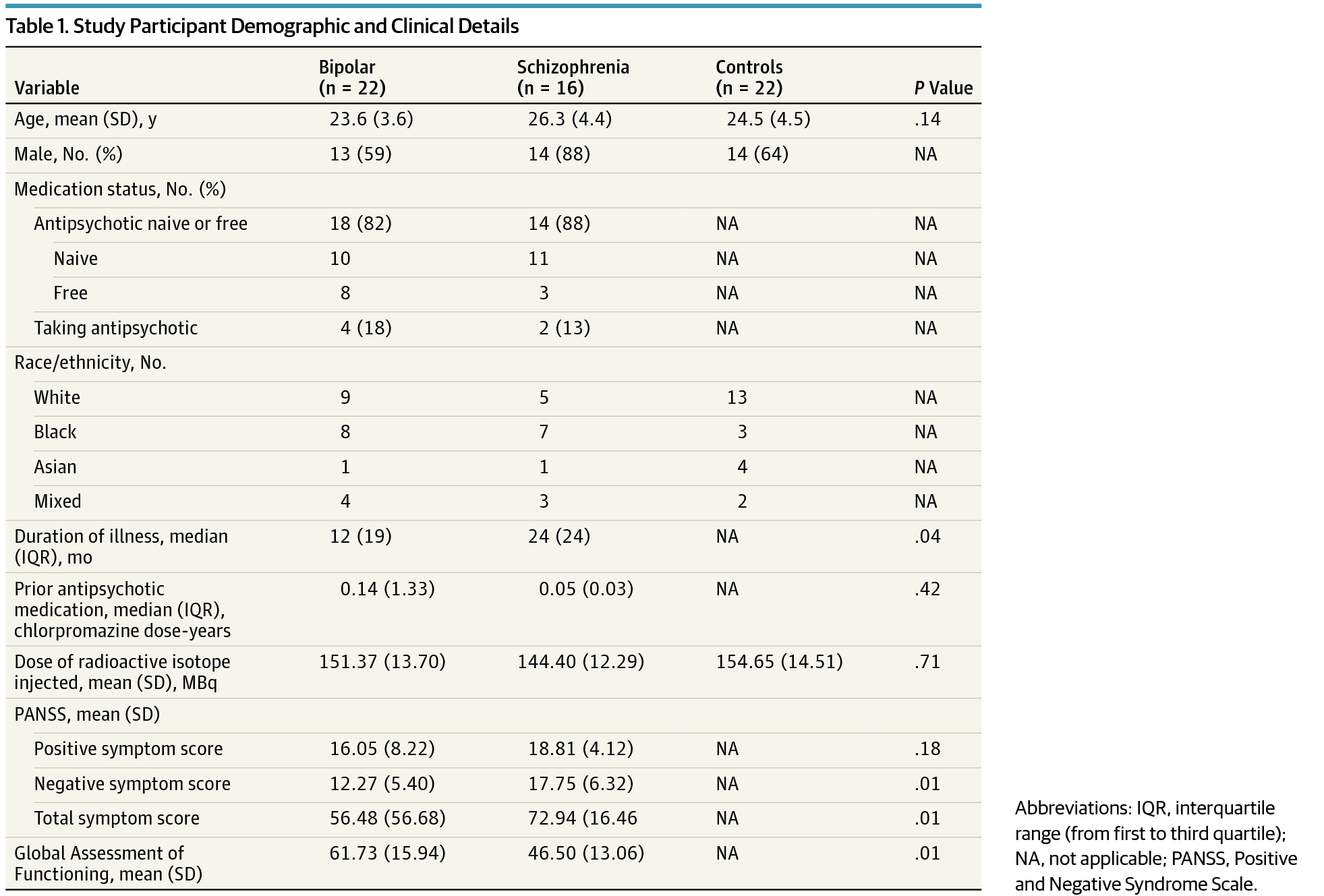JAMA Psychiatry ( IF 25.8 ) Pub Date : 2017-12-01 , DOI: 10.1001/jamapsychiatry.2017.2943 Sameer Jauhar 1, 2 , Matthew M Nour 1, 3 , Mattia Veronese 4 , Maria Rogdaki 3 , Ilaria Bonoldi 1, 2 , Matilda Azis 1 , Federico Turkheimer 4 , Philip McGuire 1, 2 , Allan H Young 5 , Oliver D Howes 1, 2, 3

|
Importance The dopamine hypothesis suggests that dopamine abnormalities underlie psychosis, irrespective of diagnosis, implicating dopamine dysregulation in bipolar affective disorder and schizophrenia, in line with the research domain criteria approach. However, this hypothesis has not been directly examined in individuals diagnosed with bipolar disorder with psychosis.
Objectives To test whether dopamine synthesis capacity is elevated in bipolar disorder with psychosis and how this compares with schizophrenia and matched controls and to examine whether dopamine synthesis capacity is associated with psychotic symptom severity, irrespective of diagnostic class.
Design, Setting, and Participants This cross-sectional case-control positron emission tomographic study was performed in the setting of first-episode psychosis services in an inner-city area (London, England). Sixty individuals participated in the study (22 with bipolar psychosis [18 antipsychotic naive or free], 16 with schizophrenia [14 antipsychotic naive or free], and 22 matched controls) and underwent fluorodihydroxyphenyl-l-alanine ([18F]-DOPA) positron emission tomography to examine dopamine synthesis capacity. Standardized clinical measures, including the Positive and Negative Syndrome Scale, Young Mania Rating Scale, and Global Assessment of Functioning, were administered. The study dates were March 2013 to November 2016.
Main Outcomes and Measures Dopamine synthesis capacity (Kicer) and clinical measures (Positive and Negative Syndrome Scale, Young Mania Rating Scale, and Global Assessment of Functioning).
Results The mean (SD) ages of participants were 23.6 (3.6) years in 22 individuals with bipolar psychosis (13 male), 26.3 (4.4) years in 16 individuals with schizophrenia (14 male), and 24.5 (4.5) years in controls (14 male). There was a significant group difference in striatal dopamine synthesis capacity (Kicer) (F2,57 = 6.80, P = .002). Kicer was significantly elevated in both the bipolar group (mean [SD], 13.18 [1.08] × 10−3 min−1; P = .002) and the schizophrenia group (mean [SD], 12.94 [0.79] × 10−3 min−1; P = .04) compared with controls (mean [SD], 12.16 [0.92] × 10−3 min−1). There was no significant difference in striatal Kicer between the bipolar and schizophrenia groups. Kicer was significantly positively correlated with positive psychotic symptom severity in the combined bipolar and schizophrenia sample experiencing a current psychotic episode, explaining 27% of the variance in symptom severity (n = 32, r = 0.52, P = .003). There was a significant positive association between Kicer and positive psychotic symptom severity in individuals with bipolar disorder experiencing a current psychotic episode (n = 16, r = 0.60, P = .01), which remained significant after adjusting for manic symptom severity.
Conclusions and Relevance These findings are consistent with a transdiagnostic role for dopamine dysfunction in the pathoetiology of psychosis and suggest dopamine synthesis capacity as a potential novel drug target for bipolar disorder and schizophrenia.
中文翻译:

在双相情感障碍和精神分裂症中使用正电子发射断层成像对精神病的跨诊断多巴胺假说进行检验
重要性 多巴胺假说表明多巴胺异常是精神病的基础,无论诊断如何,都暗示双相情感障碍和精神分裂症中的多巴胺失调,符合研究领域标准方法。然而,这一假设尚未在被诊断患有双相情感障碍和精神病的个体中直接检验。
目的 测试双相情感障碍伴精神病患者的多巴胺合成能力是否升高,以及与精神分裂症和匹配对照相比如何提高,并检查多巴胺合成能力是否与精神病症状严重程度相关,无论诊断类别如何。
设计、环境和参与者 本横断面病例对照正电子发射断层扫描研究是在市中心地区(英国伦敦)的首发精神病服务环境中进行的。60 人参与了这项研究(22 名双相精神病[18 名抗精神病药未使用或未使用],16 名精神分裂症[14 名抗精神病药未使用或未使用],以及 22 名匹配的对照)并接受了氟二羟苯基-L-丙氨酸([ 18 F]-DOPA)正电子发射断层扫描检查多巴胺合成能力。进行了标准化临床测量,包括阳性和阴性综合征量表、年轻躁狂评定量表和整体功能评估。研究日期为 2013 年 3 月至 2016 年 11 月。
主要结果和措施 多巴胺合成能力 (Ki cer ) 和临床措施 (阳性和阴性综合征量表、年轻躁狂评定量表和全球功能评估)。
结果 22 名双相精神病患者(13 名男性)参与者的平均(SD)年龄为 23.6(3.6)岁,16 名精神分裂症患者(14 名男性)为 26.3(4.4)岁,对照组为 24.5(4.5)岁( 14 男)。纹状体多巴胺合成能力 (Ki cer )存在显着的组间差异( F 2,57 = 6.80, P = .002)。Ki cer在双极组(平均 [SD],13.18 [1.08] × 10 -3 min -1;P = .002)和精神分裂症组(平均 [SD],12.94 [0.79] × 10 - 3分钟-1 ; P = .04) 与对照组相比(平均值 [SD],12.16 [0.92] × 10 -3 min -1)。双相和精神分裂症组之间的纹状体 Ki cer没有显着差异。Ki cer与正在经历当前精神病发作的双相和精神分裂症联合样本中的阳性精神病症状严重程度呈显着正相关,这解释了症状严重程度差异的 27%(n = 32,r = 0.52,P = .003)。在经历当前精神病发作的双相情感障碍患者中, Ki cer与阳性精神病症状严重程度之间存在显着的正相关(n = 16, r = 0.60,P = .01),在调整躁狂症状严重程度后仍然显着。
结论和相关性 这些发现与多巴胺功能障碍在精神病病理学中的跨诊断作用一致,并表明多巴胺合成能力作为双相情感障碍和精神分裂症的潜在新药靶点。



























 京公网安备 11010802027423号
京公网安备 11010802027423号